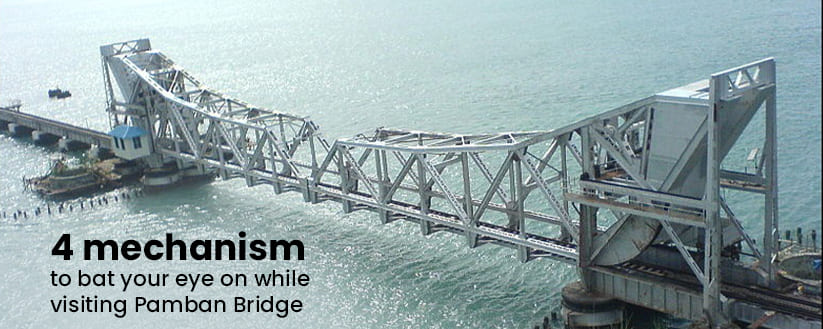4 mechanism to bat your eye on while visiting Pamban Bridge
Pamban, the first sea bridge of India, has been under the limelight since it was built. The mechanism of the bridge has grabbed the attention of millions across the world. Here we are to take a closer view of its mechanism. The cantilever bridge is 100-year-old and was built with robust technology by a German Engineer, Scherzer, in 1911, and the construction ended in 1914. It is a masterpiece of railway engineering.
The railway bridge is 41 ft above sea level, consists of 143 piers, and has a double-leaf bascule section with a Scherzer rolling-type lift span that can be raised to let ships pass. It connects the town of mandapam with mainland India with Rameshwaram on Pamban Island.
1. Lifting Technology
The bridge is more than 2 km long, and it is India's first vertical lift sea bridge which would open upwards to let the mammoth ships pass through. Railway Vikas Nigam Limited is developing it.
The scene of the bridge opening to let the boats and small ships pass underneath the bridge is an absolute feast for the eyes of the spectators, which is a reward for engineering and intelligence.
First, the Scherzer roll and lift span is triggered by applying the principle of spurs and gears to gain a significant mechanical edge.
Next, the Port-Executive informs the bridge operator about the date and time of the transport crossing.
Finally, the bridge operator informs the station master and the controller before he lifts the bridge. The entire operation takes nearly 40 to 50 minutes.
2. Double-leaf bascule section
What is a bascule?
The bascule bridge is a lifting or moveable bridge with an equilibrium that continuously balances a span, or leaf, with its upward movement to offer clearance for boat traffic. It may be single- or double-leafed.
Double-leaf bascule
Pamban bridge is designed with a double bascule section where the main girders can be lifted together with a deck about the hinge at the end of the span. Each half of the lifting span weighs around 415 tonnes. The two leaves of the bridge open manually by using the levers. The length of the double-leaf bascule section is 289 ft.
3. Construction materials
The stones and concrete metals for the bridge construction were brought in rail from a quarry 260 km away from Pamban. Sands from a site located 100 km away. To construct the Pamban Railway Bridge, four thousand tons of cement, 1,36,000 cubic feet of clay, 18,000 cubic feet of crushed metal, 1,63,000 cubic feet of sand, and 80,000 cubic feet of boulders were used.
4. Duplex stainless steel to protect against corrosion
The first bridge to use stainless steel components. A progressive initiative was taken by the Indian railway. Being located in the second most corrosive region in the world, corrosion was a rising issue. To eliminate corrosion and other maintenance issues, railways use stainless steel as an essential component for fabricating four girders in the new bridge, which is under construction.
Aspiring civil engineers taking inspiration from the mechanism and the marvel of architectural masterpieces across the globe should know the functioning method and the mechanism behind the Great Pamban Bridge. It is one of the few architectural projects that underwent remarkable engineering advancement during the olden days.
Pamban Bridge is one of the fascinating projects in India. It is one of the best examples that the world always embraces the new coming of technological advancements so that humans can utilize them to the fullest for their lifetime convenience. This is the place where the learning applies. Engineering teaching has been a reliable instrument for success from fundamental to advanced learning. Teaching in an engineering college should inspire students to bring out their innovation in every way possible, leading them to build a masterpiece. The courses we study should empower the students to create architecture with state-of-art infrastructure. And the college they choose should enable the students to bring out their skills, and the student needs to pick a wise college.
Explore the courses of SREC: https://mech.srec.ac.in/


